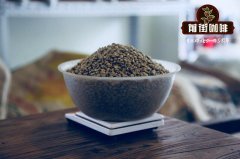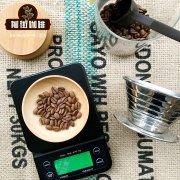What is the difference between Yejia Xuefei washing and sun-drying raw beans? [washing] and [sun Yega]

Professional coffee knowledge exchange more coffee bean information please follow the coffee workshop (Wechat official account cafe_style)
What is the difference between Yejia Xuefei washing and sun-drying raw beans? What is the difference between [washing] and [sun Yega] flavor trend?
According to the map, Yega Xuefei is just a by-product area with the highest elevation leaning against mountains and water in Ethiopia's Sidamo Sidamo province. Because the mode of production and flavor are too prominent, the unique flavor has become the most famous producing area in Africa.
The mountain villages in the Yejasuefei area are foggy all the year round, with a gentle breeze, cool but not hot, and rain but not damp. Originally planted in the mountains by European monks, most of the Yejashafi coffee trees are planted in farmers' own backyards or mixed with other crops in the fields, with little yield per household, which is a typical pastoral coffee. Yejia Chuefeiduo uses water washing to retain the fresh and clean taste, but a small number of fine beans are deliberately sunburned to enhance the charming fruit aroma and mellow thickness.
The unique location of the area is an advantage that every coffee plantation will emphasize, but Yega Xuefei also has a different point. From the search materials or the pictures provided by the coffee farm, every coffee farmer is smiling. A relaxed and comfortable smile from the heart. If coffee beans can honestly record the flavor of the earth, it is probably the pleasure gene that records these growers'"settling down and enjoying themselves." this is probably why they can give birth to the most unique regional flavor of citrus and flowers.
[coffee grading and naming]
Essel's grading is really a headache. Before I went to the production area, I thought my understanding was very clear. After going to the exporter of the Dumerso processing station, he told me that there were Grade1 and Grade2 tanning beds in front of me. I was confused all of a sudden. The highest grade of washing is Grader1, but isn't it Grade3? I also repeatedly confirmed with him that I was ridiculed and said that the beans you bought had been cheated ( file:///C:\Users\cc\AppData\Local\Temp\ksohtml\wps2C83.tmp.png). In fact, up to now, I still struggle with this problem. Let's discuss it together: Ethiopia had two grading methods. The old grading method was simply classified according to the number of defects. The highest level of beans washed in this way is Grade 1, which is what we often call G1, and the highest grade of sunlight is Grade 3, that is, G3. And often hear people say that G1 beans basically can not get, why, because to reach 0-3 defects may be zero. The current grading method is based on the combination of physical properties and cup flavor characteristics established by ECX. All coffee will eventually be defined as three types according to the way it is treated in the sun or in water:
The number of defects is small, and the cup test has high flavor quality.
It can not reach the boutique grade, but it is higher than the domestic consumption grade.
Coffee with a relatively poor flavor caused by a large number of defects (unripe beans), out of season and poor storage. Among them, Specialty and Commerical are aimed at the international export market, and Local is the coffee sold for the domestic market. For the specific grading criteria, we respectively extract the ECX scoring criteria as follows: [definition of scoring for washing treatment]
Physical features account for 40%: number of defects (20%), appearance size (10%), color (5%), smell (5%)
The cup test quality accounts for 60%: cleanliness (15%), acidity (15%), taste (15%), flavor characteristics (15%). G1-G9 scores are as follows:
UG (p) indicates that under graded (parchment) is not qualified for ECX classification, while UG (NP) means shelled beans that are not qualified for ECX classification, that is, normal raw beans.
Excerpt from ECX Coffee Classification [rating definition of sun treatment]
Physical characteristics account for 40%: number of defects (30%), odor (10%)
Cup test quality accounts for 60%: cleanliness (15%), acidity (15%), taste (15%), flavor characteristics (15%) G1-G9 scores are as follows: the last two items put a question mark first, which is currently understood as coffee with a large number of unripe beans and mediocre flavor. [Speciality Grade]
According to the respective scoring standards of the above two processing methods, for the second cup test evaluation of coffee rated as G1-G3, the cup test quality is scored according to the current SCAA cup test standard: the cup quality is graded again after scoring, and the criteria are as follows: finally, we get a summary of Q1Query Q2jing3 teacher:
According to the method of treatment, all coffee is classified as: sun exposure, water washing.
Each of them has 9 grades of G1-G9 according to the physical characteristics and the basic quality of cup test.
Among them, G1-G3 was tested again, and its flavor attributes were evaluated more carefully (according to SCAA standard). Among them, G1Magi G2 with no less than 85 points was rated as Q1, among them, G2 G3 was rated as Q2 for those between 80 and 85, G3 was rated as G3 for all G1 mentions below 80, and Q1 and Q2 were classified as Specialty Grade export.
G4-G9 keeps the original classification unchanged and is classified as CommercialGrade export together with G3.
[sun Jie Jia Xuefei]
Sun-treated Yejia Xuefei is rich in tropical fruit flavors such as fruit, strawberry and pineapple, characterized by obvious sweetness and mellow taste.
Flavor: fruity strawberry pineapple tropical fruit
Tonality: fruit tonality
[Yejia Sheffield Coffee beans]
The water washing method is widely used in Yejia Xuefei producing area, through the process of washing, the peel and pulp are removed, and the immature fruits are screened out, and the taste is fresher and sweeter than the sun method.
Flavor: rich fruit, grape blueberry
Tonality: fruit tonality
Important Notice :
前街咖啡 FrontStreet Coffee has moved to new addredd:
FrontStreet Coffee Address: 315,Donghua East Road,GuangZhou
Tel:020 38364473
- Prev

Is the price of rose summer coffee beans expensive in rose summer village? selection procedure of bidding batches of rose summer coffee beans in rose summer village
Professional coffee knowledge exchange more coffee bean information please follow the coffee workshop (Wechat official account cafe_style) in recent years the increasingly hot coffee farm in Rose Xia Village has recently started its own bidding activities. So, what is the beauty of this coffee farm in Ruoxia Village, which is claimed to be from the hometown of Rosa, worthy of many raw bean merchants to compete for? Located in Ethiopia and Kenny
- Next

Background story of coffee manor in Rosa Village how much is a cup of coffee in Rose Village
Professional coffee knowledge exchange more coffee bean information please follow the coffee workshop (Wechat official account cafe_style) the best and most original coffee-Gesha Village Rosa Village Coffee Manor background story Gesha Village trip began in 2007, when Mr. Adam Overton and Miss Rachel Samuel were making information about Ethiopian coffee for the Ethiopian government.
Related
- Detailed explanation of Jadeite planting Land in Panamanian Jadeite Manor introduction to the grading system of Jadeite competitive bidding, Red bid, Green bid and Rose Summer
- Story of Coffee planting in Brenka region of Costa Rica Stonehenge Manor anaerobic heavy honey treatment of flavor mouth
- What's on the barrel of Blue Mountain Coffee beans?
- Can American coffee also pull flowers? How to use hot American style to pull out a good-looking pattern?
- Can you make a cold extract with coffee beans? What is the right proportion for cold-extracted coffee formula?
- Indonesian PWN Gold Mandrine Coffee Origin Features Flavor How to Chong? Mandolin coffee is American.
- A brief introduction to the flavor characteristics of Brazilian yellow bourbon coffee beans
- What is the effect of different water quality on the flavor of cold-extracted coffee? What kind of water is best for brewing coffee?
- Why do you think of Rose Summer whenever you mention Panamanian coffee?
- Introduction to the characteristics of authentic blue mountain coffee bean producing areas? What is the CIB Coffee Authority in Jamaica?

